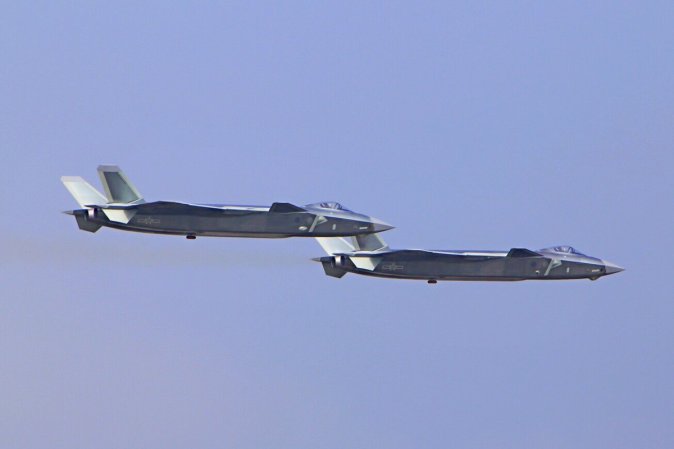


On December 18, 2014, the 6th J-20 stealth fighter prototype took off from the Chengdu Aviation Corporation factory. At six airframes, that makes the J-20 the most numerous non-American stealth fighter in the world (the Russian T-50 PAK-FA has only four airworthy examples, after an accident in June 2014 destroyed the fifth model). So far, 2014 has seen the debut flights of four J-20 fighters (2011, 2012, 2013 and 2015).

Fifth generation fighters are commonly accepted to have a stealthy airframe, an active electronically scanned radar, networked sensors and supercruise engines (supercruise engines provide enough velocity by themselves to reach supersonic speeds, without using fuel thirsty afterburners). Currently, the J-20 uses an advanced version of the Russian Al-31F, which is unlikely to be fast enough to supercruise (to be fair, the F-35 doesn’t supercruise either).

2015 features slight improvements to the airframe, compared to 2011 and 2012, with changed tail booms around the engine nozzles. The changes to the stingers are likely to accommodate rearwards facing radar, similar to the secondary radar arrangements on the T-50 PAK-FA. Having secondary radar arrays located on the rear and side will give a fighter 360 degree radar coverage, allowing for greater situational awareness and the ability to shoot long ranged radar guided missiles against pursuing aircraft. 2013 and 2015 both have retractable inflight refueling probes located alongside the cockpit, to extend their operational range.
Coming less than three weeks after the fifth prototype, “2013”, first flew on November 29, 2014, the rapid production of J-20 stealth fighters suggests that China’s flagship fighter program is entering Low Rate Initial Production (LRIP). LRIP is the stage in the development of military platforms where the design is essentially frozen, thus allowing the manufacturing to begin gaining experience by producing small numbers of the finished design (the F-35 is currently on LRIP Batch 8). The rapid production of four similar fighters within a year suggests that China has settled on the final design of the J-20, and it is likely that production of the first squadron could happen in 2015. The first squadron of 20-24 fighters would be produced in 2015 and early 2016, going to the China Flight Test Evaluation Regiment to develop tactics for the J-20’s advanced capabilities. Assuming things go to schedule, the first J-20 squadron would be ready for combat in 2017.

A 2016-2017 introduction places the J-20’s debut in the same window as the Russian PAK-FA fighter, as well as the USMC F-35B and USAF F-35A. More importantly, the J-20 would make the PLAAF the first Asian air force to have a fifth generation fighter, definitively shifting the balance of indigenous Asian air superiority to China for the first time in history. Future iterations of the J-20 would be equipped with the supercruise capable WS-15 Chinese turbofan engine, and possibly advanced systems like directed energy weapons (lasers) and networked UAVs.
You may also be interested in:
China’s J-31 Stealth Fighter: Then and Now
Stealth Radar Tests on Passenger Jet
Photos Emerge of China’s 4th New Stealth Fighter
Instagram Style Sepia: The Way to Launch Chinese Fighter Jets (and Dodge the Censors)?
New Chinese Fifth Generation Fighter Jet- J31 Performs More Flight Tests















